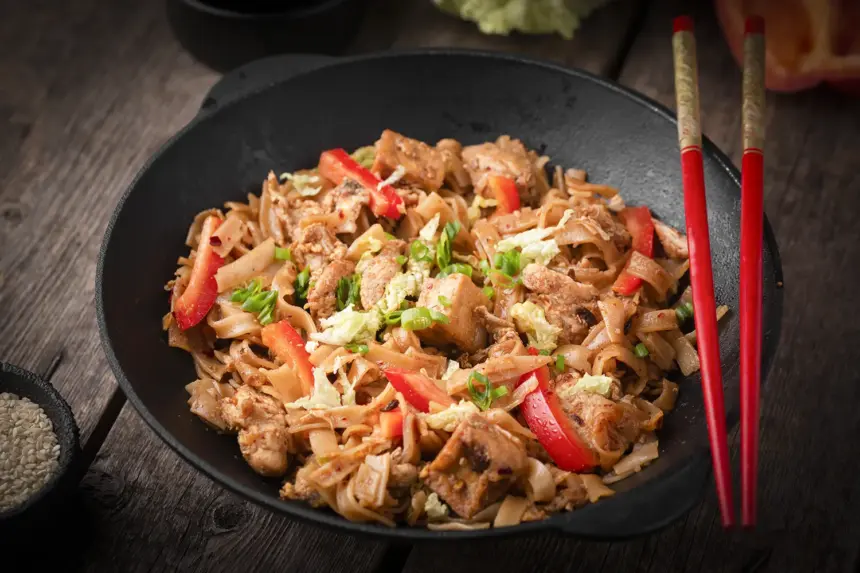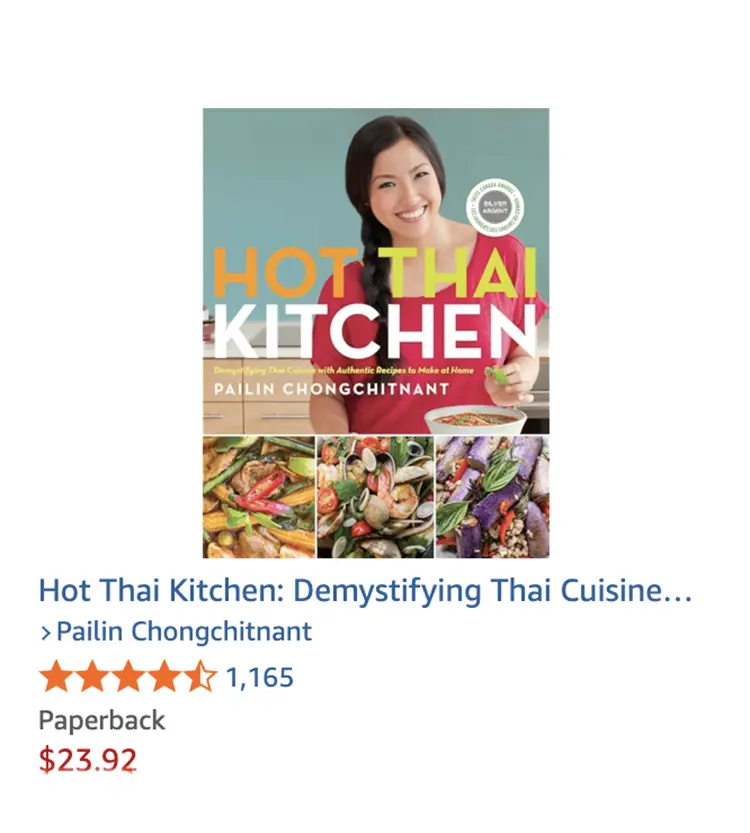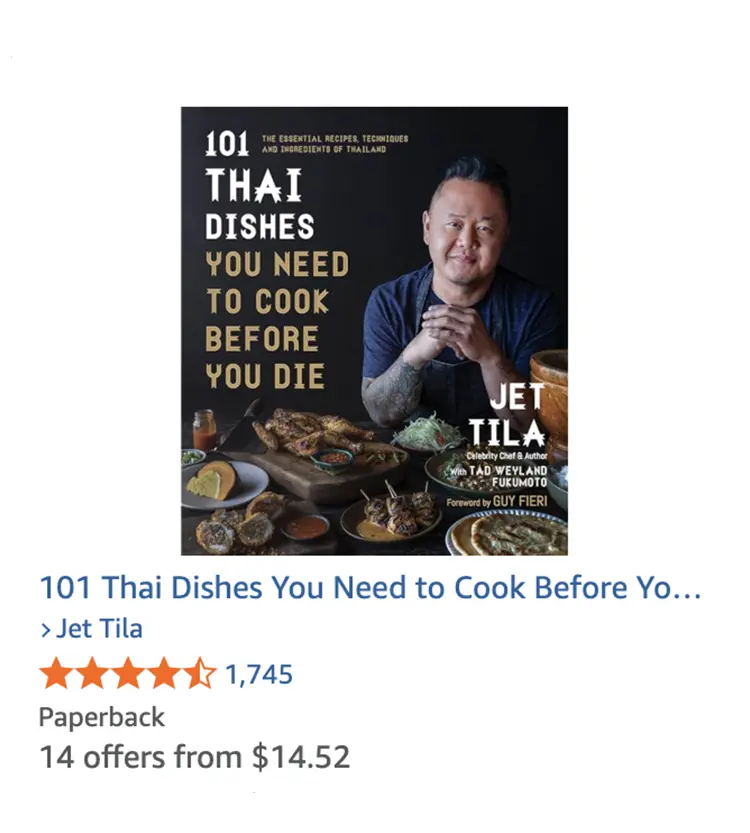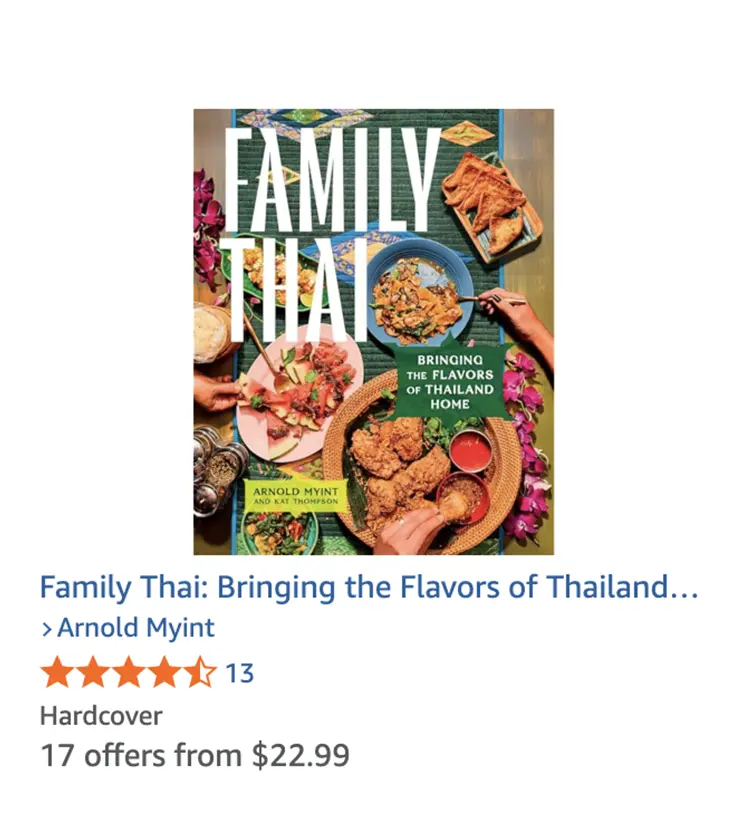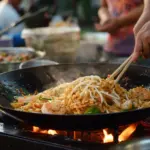Beyond the Bowl: Unlocking the Secrets of Perfect Pad See Ew (Your Ultimate Guide to Thai Stir Fried Noodle Bliss!)
Hey there, fellow food adventurers! Ever find yourself dreaming of chewy, wide rice noodles coated in a glossy, savory-sweet sauce, mingling with tender slices of meat, crisp-chewy Chinese broccoli, and fluffy bits of scrambled egg? If that image just made your stomach rumble and your taste buds tingle, chances are you’ve encountered the magic that is Pad See Ew.
- What Exactly Is Pad See Ew? Decoding the Name and the Dish
- The Symphony of Sauce: Unpacking the Flavor Profile
- The Essential Players: A Closer Look at the Ingredients
- The Dance in the Wok: Mastering the Technique
- Pad See Ew vs. The Noodle Crew: How It Stacks Up
- A Hint of History: Where Did Pad See Ew Come From?
- Craving Pad See Ew? Making it at Home (The Narrative Guide)
- Tips for Pad See Ew Perfection at Home
- Serving Your Pad See Ew
- Why We Can’t Get Enough of Pad See Ew
- Final Thoughts
This isn’t just any stir-fried noodle dish. Oh no. Pad See Ew holds a special place in the hearts of Thai food lovers worldwide, often standing shoulder-to-shoulder with the ever-popular Pad Thai, yet offering a completely different, deeply satisfying experience. While Pad Thai sings with bright, tangy, and nutty notes, Pad See Ew hums a rich, savory, slightly sweet, and wonderfully comforting tune. It’s the kind of dish that feels like a warm hug in a bowl, perfect for a quick weeknight dinner, a satisfying lunch, or whenever you need a serious flavor boost.
But what makes Pad See Ew so uniquely captivating? Is it the irresistible chewiness of those wide, flat noodles? The signature dark, glossy sauce that clings to every strand? The subtle bitterness of the Chinese broccoli cutting through the richness? Or perhaps it’s the elusive “wok hei” – the smoky breath of the wok that infuses everything with an irresistible aroma?
Let’s dive deep into the world of Pad See Ew, exploring everything from its humble origins to the essential ingredients, the crucial cooking techniques, and why it deserves a top spot on your list of favorite comfort foods. And who knows, by the end of this, you might feel inspired to fire up your own stove and create this masterpiece at home!
What Exactly Is Pad See Ew? Decoding the Name and the Dish
First things first, let’s break down the name: “Pad See Ew” (sometimes spelled Phad See Ew or Phat Si Io). In Thai, “Pad” (ผัด) means “stir-fried.” “See Ew” (ซีอิ๊ว) refers to soy sauce. So, quite literally, it translates to “stir-fried with soy sauce.” Simple, right? Yet, like many great dishes, its beauty lies in this simplicity and the expert execution of a few key components.
At its core, Pad See Ew is a stir-fry featuring:
- Wide Rice Noodles (Sen Yai): These are the non-negotiable foundation. Fresh, wide, flat rice noodles are preferred for their unique chewy texture and ability to absorb the sauce.
- Chinese Broccoli (Gai Lan or Kai-lan): This leafy green vegetable with thick stems adds a slightly bitter edge and a satisfying crunch that balances the richness of the noodles and sauce.
- Protein: Typically thinly sliced pork, chicken, beef, or shrimp. Tofu is also a popular vegetarian option.
- Egg: Usually scrambled directly in the wok and mixed in.
- The Signature Sauce: A magical concoction primarily based on dark soy sauce, light soy sauce, oyster sauce, and often a touch of sugar.
When combined in a scorching hot wok, these ingredients transform into a dish that is savory, slightly sweet, deeply flavorful, and boasts a delightful contrast in textures – soft noodles, tender meat, crisp-chewy greens, and fluffy egg.
The Symphony of Sauce: Unpacking the Flavor Profile
The sauce is arguably the soul of Pad See Ew. It’s not overly complex, but the combination of the soy sauces and oyster sauce creates a unique depth and umami that is instantly recognizable.
- Dark Soy Sauce (See Ew Dam – ซีอิ๊ว ดำ): This is key for both color and a touch of sweetness. It’s thicker, less salty than light soy sauce, and provides that beautiful dark brown hue to the noodles. Don’t skip this!
- Light Soy Sauce (See Ew Kao – ซีอิ๊ว ขาว): This is your main source of saltiness. Use a good quality Thai or Chinese light soy sauce for the best flavor.
- Oyster Sauce (Nam Man Hoi – น้ำมันหอย): Adds a crucial layer of savory, slightly sweet, and complex umami. It’s a staple in many Thai and Chinese stir-fries.
- Sugar: Often granulated white sugar or sometimes palm sugar is used to add sweetness that balances the salty and savory elements. It also helps with caramelization on the noodles.
- Vinegar (Optional but Recommended): A small splash of white vinegar or rice vinegar can add a hint of acidity that brightens the overall flavor.
- White Pepper: A common spice in Thai and Chinese cooking that adds a subtle pungency different from black pepper.
Getting the sauce ratio right is crucial for that perfect balance. Too much dark soy and it’s too sweet/dark; too much light soy and it’s too salty; not enough oyster sauce and it lacks depth. Many home cooks premix their sauce ingredients before hitting the wok, which is a brilliant tip for speed and consistency.
The Essential Players: A Closer Look at the Ingredients
While the sauce provides the flavor base, the other ingredients bring texture, substance, and visual appeal.
1. The Noodles (Sen Yai – เส้นใหญ่): These are the undisputed heroes. “Sen Yai” translates to “big lines.” They are wide, flat, and typically made from rice flour and water.
- Fresh vs. Dry: Fresh wide rice noodles are vastly superior if you can find them. They have a softer, chewier texture and cook up beautifully. They often come in sheets or pre-cut. If using fresh, they might need to be separated gently before stir-frying.
- Dry: If fresh isn’t available, you can use dried wide rice noodles (often labeled “rice stick noodles” or similar). You’ll need to rehydrate them according to package directions, usually by soaking them in hot water until pliable but not mushy. Be careful not to oversoak!
The magic of these noodles is how they absorb the sauce and develop slightly caramelized, sometimes even slightly crispy edges when hitting the hot wok.
2. Chinese Broccoli (Gai Lan / Kai-lan – คะน้า): This is the traditional green for Pad See Ew. It has thick stems and large, flat leaves. The stems are slightly bitter and crunchy, while the leaves are tender.
- Preparation: The stems are usually sliced on the bias (diagonally) and added to the wok slightly before the leaves, as they take longer to cook.
- Substitutes: While Gai Lan is traditional and best, if you absolutely can’t find it, you could try broccolini or even regular broccoli florets (cut small), but the flavor and texture won’t be quite the same. Some people use regular kale or even bok choy, but again, Gai Lan is king here.
3. The Protein: Thinly slicing your chosen protein is key for quick and even cooking in the high heat of the wok.
- Chicken/Pork/Beef: Slice against the grain for tenderness. Marinating briefly in a little soy sauce or cornstarch mixture can improve texture.
- Shrimp: Add towards the end as they cook very quickly.
- Tofu: Use firm or extra-firm tofu, pressed to remove excess water, then cubed or sliced and pan-fried or deep-fried separately until golden before adding to the stir-fry for better texture.
4. The Egg: Usually, one or two eggs are lightly scrambled directly in the wok after the protein and vegetables have had a head start. They cook quickly and get mixed into the noodles, adding richness and binding things together slightly.
The Dance in the Wok: Mastering the Technique
This is where the magic truly happens and where you chase that elusive “wok hei.” Pad See Ew is a dish cooked fast over high heat.
- High Heat is Your Friend: Get your wok (or a large, heavy-bottomed skillet if you don’t have a wok) screaming hot before you add any oil. This is essential for achieving that slightly smoky flavor and preventing sticking.
- The Wok Hei: This term refers to the unique aroma and flavor imparted by stir-frying in a seasoned wok over intense heat. It’s a complex mix of caramelization, charring, and smoky flavor from the oil vaporizing. While a home stove might not replicate the power of a professional gas burner perfectly, getting your pan as hot as possible is the way to chase it.
- Sequence Matters: Ingredients are typically added in stages based on their cooking time.
- Oil and aromatics (like minced garlic).
- Protein.
- Gai Lan stems, then leaves.
- Egg (scrambled to the side or added after removing other ingredients temporarily).
- The noodles.
- The pre-mixed sauce.
- Keep it Moving: Continuous stirring and tossing are vital to ensure even cooking, prevent burning, and get that lovely char on the noodles.
- Don’t Overcrowd: Cook in batches if necessary, especially if you’re making a large quantity. Overcrowding the pan lowers the temperature and steams the food instead of stir-frying it, preventing that essential caramelization and wok hei.
- Noodle Prep: Some cooks quickly stir-fry the noodles first with a little oil and dark soy sauce before adding other ingredients. This helps them develop color and a bit of char initially, then they are set aside and added back in with the sauce at the very end. This is a pro move for maximizing noodle texture and flavor.
Pad See Ew vs. The Noodle Crew: How It Stacks Up
Pad See Ew is often compared to other popular Thai noodle dishes. Understanding the differences highlights what makes Pad See Ew special.
- Pad Thai: The most famous! Uses thinner rice noodles, a sauce based on tamarind, fish sauce, sugar, and often lime. It’s typically garnished with peanuts, bean sprouts, and chives, and has a distinctly sweet, sour, and nutty profile. Texture is softer noodles, crunch from peanuts/sprouts.
- Pad Kee Mao (Drunken Noodles): Often uses the same wide rice noodles as Pad See Ew, but the flavor profile is dramatically different. Pad Kee Mao is known for being spicy, featuring chili, garlic, holy basil, and sometimes fingerroot (krachai). The sauce is less sweet than Pad See Ew, more savory and herbaceous.
While all are delicious stir-fried noodle dishes, Pad See Ew stands out with its focus on the savory-sweet balance, the chewiness of the wide noodles, the specific inclusion of Chinese broccoli, and the lack of significant spice (though you can add chili flakes to taste!).
A Hint of History: Where Did Pad See Ew Come From?
Like many popular noodle dishes in Thailand, Pad See Ew has strong roots in Chinese cuisine, particularly in dishes brought by Chinese immigrants over centuries. Stir-fried noodles are a staple across many Asian cultures, and the use of soy sauce is central to Chinese cooking. Pad See Ew evolved in Thailand, adapting to local ingredients and tastes (like the inclusion of Gai Lan). It quickly became a beloved street food and home-cooked meal – simple, affordable, and incredibly satisfying. It’s a testament to the delicious fusion of culinary traditions.
Craving Pad See Ew? Making it at Home (The Narrative Guide)
While I can’t give you a precise recipe with cup measurements right here (a full recipe deserves its own dedicated page!), I can walk you through the process so you feel confident tackling it in your own kitchen.
- Prep Everything: This is rule number one for any stir-fry, but especially Pad See Ew because it cooks so fast. Slice your protein thinly. Separate your Gai Lan stems from leaves and slice the stems diagonally; chop the leaves into large pieces. Mince your garlic. Separate your fresh noodles (or soak your dry ones). Crucially, mix all your sauce ingredients in a small bowl – have it ready to pour!
- Get Your Pan Hot: Place your wok or skillet over high heat until it’s smoking lightly. Add your cooking oil (a neutral oil like vegetable or peanut oil is best). Swirl to coat.
- Aromatics & Protein: Add the minced garlic and stir-fry for just a few seconds until fragrant – don’t burn it! Add your protein and stir-fry, breaking it up, until it’s mostly cooked through and has a little color.
- Veggies & Egg: Push the protein to one side of the pan. Add the Gai Lan stems and stir-fry for a minute or two. Then add the leaves and stir-fry until they just start to wilt. Push everything to the side again (or scoop out the protein and veggies temporarily if needed). Add a touch more oil if the pan is dry, then crack in your eggs. Quickly scramble them, breaking them into pieces.
- Noodle Time! Add your prepared wide rice noodles to the pan. If you’re doing the “noodle first” method, you’d add them here after step 2, stir-fry with a little oil and maybe dark soy for color, then set aside and add back now. If not, add them straight in with the other ingredients.
- Sauce & Stir-Fry! Pour your pre-mixed sauce evenly over everything in the pan. Now, using spatulas or cooking spoons, aggressively but carefully toss and stir-fry everything together. The goal is to distribute the sauce evenly, coat all the noodles, and get some caramelization and char on the noodles and edges of the ingredients. Keep stir-frying for 2-4 minutes until the noodles are heated through, the sauce is glossy and thickened slightly, and you see those lovely slightly browned bits. This is the crucial stage for developing wok hei!
- Taste and Adjust: Give it a quick taste. Does it need a tiny pinch more sugar? A splash more soy sauce? A dash of vinegar? Adjust if necessary, tossing quickly.
- Serve Immediately: Pad See Ew is best eaten straight from the wok while piping hot!
Tips for Pad See Ew Perfection at Home
- Ingredient Quality: Use good quality soy sauces and oyster sauce. Fresh noodles make a huge difference.
- Prep is King: Seriously, have everything chopped, sliced, and measured before you turn on the heat. The cooking process is lightning-fast.
- High Heat, Patience with Pan Heating: Give your wok/pan time to get properly hot before adding oil and ingredients.
- Don’t Overcrowd: Cook in batches if your pan isn’t large enough for all the ingredients to have space.
- Noodle Management: If using fresh noodles that are stuck together, gently separate them before adding them to the wok. Tearing them apart in the wok is difficult and can make them mushy.
- Master the Toss: Practice your stir-frying technique. The goal is to keep things moving and ensure even exposure to the heat.
Serving Your Pad See Ew
Pad See Ew is typically served unadorned in a bowl or on a plate. However, common condiments you might find at a Thai street food stall or restaurant include:
- Dried chili flakes
- Prik Nam Pla (fish sauce with sliced chilies)
- Vinegar with sliced chilies (Prik Dong)
- A small bowl of sugar (for those who want it sweeter)
Allowing diners to customize the spice or tang level is part of the fun!
Why We Can’t Get Enough of Pad See Ew
Pad See Ew is more than just a meal; it’s a comfort food experience. It’s satisfyingly filling thanks to the substantial noodles. Its flavor profile – that perfect balance of savory, sweet, and umami – is incredibly addictive without being overly spicy (unless you add chilies!). The textures are delightful – the chew of the noodles, the slight bite of the Gai Lan, the tender protein. It’s a dish that feels both nourishing and indulgent.
It’s also wonderfully adaptable. While the core ingredients are key, you can easily swap proteins or even add other vegetables like carrots or bell peppers (though traditionalists might raise an eyebrow!).
Final Thoughts
Whether you’re ordering it at your favorite Thai restaurant, discovering it at a bustling street food market, or bravely attempting to recreate its magic in your own kitchen, Pad See Ew is a dish that promises a deeply satisfying culinary journey. It’s a beautiful example of how simple ingredients, combined with the right technique, can create something truly extraordinary.
So, next time you’re craving Thai, look beyond the usual suspects and give Pad See Ew the attention it deserves. Its glossy noodles, perfect sauce, and comforting flavors are waiting to win you over, one delicious bite at a time. Happy slurping!


